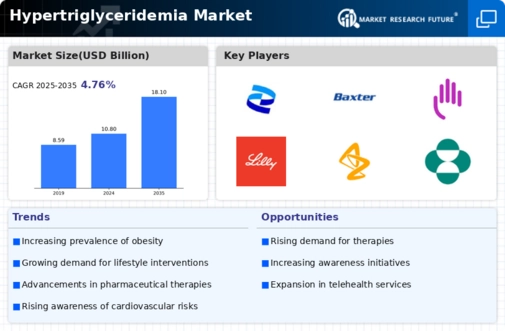Rising Healthcare Expenditure
The upward trend in healthcare expenditure is another significant driver influencing the Hypertriglyceridemia Market. As nations allocate more resources to healthcare, there is a corresponding increase in the availability of advanced diagnostic and therapeutic options for managing hypertriglyceridemia. For instance, healthcare spending has seen a notable rise, with some countries reporting increases of over 5 percent annually. This financial commitment enables healthcare providers to invest in cutting-edge technologies and treatments, enhancing patient outcomes. Furthermore, as patients become more willing to seek medical assistance for hypertriglyceridemia, the market is likely to experience a surge in demand for specialized care. This trend underscores the importance of financial resources in shaping the landscape of the Hypertriglyceridemia Market, as increased spending translates to improved access to necessary interventions.
Growing Focus on Preventive Healthcare
The shift towards preventive healthcare is significantly impacting the Hypertriglyceridemia Market. With an increasing emphasis on early detection and management of health conditions, healthcare providers are prioritizing screening for hypertriglyceridemia. This proactive approach is driven by the recognition that early intervention can mitigate the risk of severe cardiovascular events associated with high triglyceride levels. As a result, more individuals are being screened, leading to higher diagnosis rates. The market is responding to this trend by developing and promoting preventive measures, including lifestyle modification programs and educational campaigns. This focus on prevention not only enhances patient awareness but also fosters a more informed public, which is likely to drive demand for products and services within the Hypertriglyceridemia Market.
Increasing Awareness of Dietary Impact
The growing awareness of the impact of diet on triglyceride levels is a crucial driver for the Hypertriglyceridemia Market. As consumers become more educated about nutrition and its role in health, there is a noticeable shift towards healthier eating habits. This trend is reflected in the rising demand for dietary supplements and functional foods that claim to support healthy triglyceride levels. Furthermore, public health campaigns aimed at promoting heart-healthy diets are gaining traction, encouraging individuals to make informed dietary choices. This heightened awareness is likely to stimulate interest in products and services that address hypertriglyceridemia, thereby expanding the market. The intersection of dietary awareness and health management presents a unique opportunity for growth within the Hypertriglyceridemia Market.
Technological Advancements in Treatment
Technological innovations in treatment modalities are reshaping the Hypertriglyceridemia Market. Recent advancements in pharmacotherapy, including the development of novel lipid-lowering agents, have expanded the therapeutic options available for managing hypertriglyceridemia. These new treatments are designed to target triglyceride levels more effectively, offering improved outcomes for patients. Additionally, the integration of telemedicine and digital health solutions is facilitating better patient management and adherence to treatment regimens. As these technologies continue to evolve, they are likely to enhance the overall efficiency of care delivery in the Hypertriglyceridemia Market. The potential for improved patient engagement and monitoring through these advancements suggests a promising future for stakeholders in this market.
Increasing Prevalence of Hypertriglyceridemia
The rising incidence of hypertriglyceridemia is a pivotal driver for the Hypertriglyceridemia Market. Recent data indicates that approximately 25 percent of adults in various regions exhibit elevated triglyceride levels, which is a concerning statistic. This condition is often linked to lifestyle factors such as obesity, sedentary behavior, and poor dietary habits. As the prevalence of obesity continues to escalate, the number of individuals affected by hypertriglyceridemia is likely to increase. Consequently, healthcare systems are compelled to address this growing health issue, thereby propelling the demand for effective treatment options within the Hypertriglyceridemia Market. The need for innovative therapies and management strategies is becoming increasingly urgent, suggesting a robust market potential for stakeholders involved in this sector.

















Leave a Comment